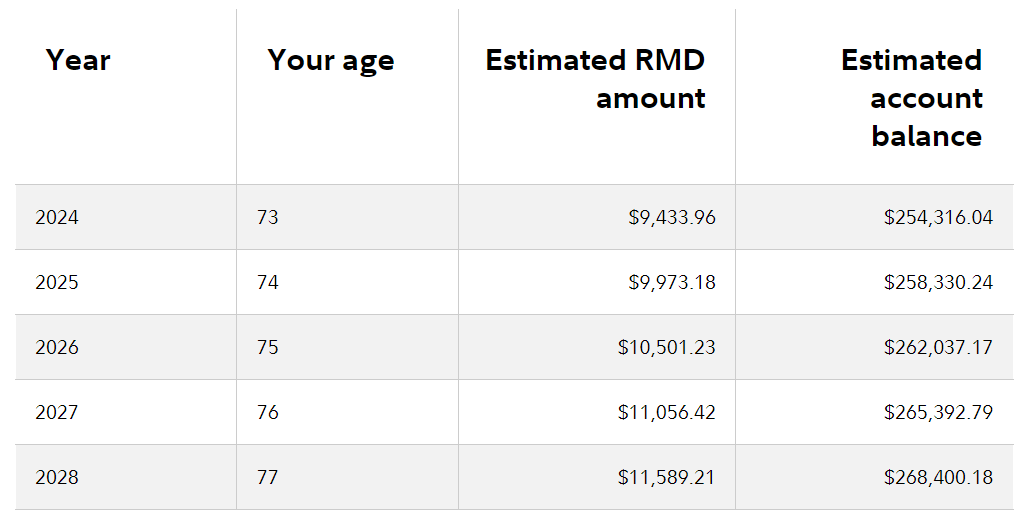
It pays off to calculate RMDs (Required minimum distributions) as you approach retirement or if you are already retired. RMDs are the minimum annual withdrawals you must make each year from most tax-deferred retirement plans (excluding Roth accounts). Your funds have grown tax-free in these accounts over the years, so RMDs are the government's way of taxing those funds incrementally. That's why RMDs are taxed as income.
Although you may be required to take RMDs from 401(k), 403(b) or other employer-sponsored retirement plans, the calculator we profile here focuses on RMDs from a traditional Individual Retirement Account (IRA).
Starting RMD withdrawals at the right age is critical, and the rules have changed recently.
- In 2020, the age for withdrawing from retirement accounts was increased from 70.5 to 72.
- The SECURE 2.0 Act raised the age to 73 for anyone who turns 73 in 2024 through 2032. You must take your first RMD by April 1 of the year after you turn 73.
- Starting in 2033, the RMD age will increase to 75 for anyone who turns 74 after Dec. 31, 2032.
Not sure how to calculate your RMD? We’ll walk you through the steps and point you to other practical resources to use.
For more detailed information, seek guidance from a qualified financial adviser or tax professional.
Calculate RMDs for a traditional IRA
We recommend using the RMD calculator designed by Fidelity, though you may also search for an RMD calculator on your broker's website. The Fidelity tool allows you to calculate the amount you must withdraw even if you are not yet 73, and accounts for your spouse's age as well. It also projects your RMDs for future years. Follow these steps:
- Input your birthdate into the Fidelity RMD Calculator.
- Choose whether your spouse (if you have one) is your only beneficiary.
- Input your IRA account balance as of December 31 of the previous year.
- Input your spouse's date of birth (if applicable).
- Input your estimated rate of return. This is the average annual growth you expect in your retirement account.
RMD calculation example:
John is a single man who turned 73 in 2024. The balance in his IRA was $250,000 on December 31, 2023, and he estimates it will grow by 5% annually. He has no spouse. This year, his required minimum distribution is $9,433.96. As the graph below shows, his annual RMD will increase over the next four years, but his account balance will not dip below its original value, assuming it continues to earn the estimated 5% interest.

RMD dates to remember
Once you turn 73, it's important to be proactive about taking required minimum distributions for IRAs, or you may face penalties. Also, you can withdraw or use your traditional IRA assets at any time, but a 10% additional tax may apply if you withdraw or use IRA assets before you reach age 59½.
Officially, RMDs are due every December 31, but the IRS allows you some wiggle room for your first withdrawal. If you decide to delay your first withdrawal, you'll have to take a second RMD before December 31. Remember that taking two RMDs in one year creates two taxable events, which may push you into a higher tax bracket.
Penalties
The IRS imposes serious penalties for taking RMDs that are too small. If you withdraw less than required, the IRS takes 50% of the difference between what you pulled out and what you should have withdrawn. You can always take larger distributions, but the required minimum distribution lets you know the smallest withdrawal you can make to meet IRS requirements. Unfortunately, you can’t use withdrawals above the minimum requirement in one year to satisfy RMDs in future years.
What accounts require RMDs?
These are the accounts that will require you to withrdaw RMDs (as long as they are not Roth accounts).
- Traditional IRAs
- Traditional 401(k)s
- Nonprofit 403(b) plans
- Government 457 plans
- Simplified Employee Pension (SEP) IRAs
- Savings Incentive Match Plan for Employees (SIMPLE) IRAs
- Profit-sharing plans
- Other defined contribution plans
You must calculate your RMD for each IRA, and you must withdraw the total amount each year. However, you may make the withdrawal from just one of the IRA accounts. This allows for easier bookkeeping and can help you draw down an IRA that is performing poorly.
Other useful resources
Calculating your RMDs manually.
You may calculate RMDs yourself. Start by determining how much you had in your IRA account as of December 31 of the previous year. Next, you can find your life expectancy factor, or the number of additional years you are expected to live according to actuarial calculations. Divide the account balance by the life expectancy factor to get the RMD.
Going to the source.
You can also visit the IRS website to find additional information on RMDs, such as what they are, the types of retirement plans that require RMDs, the timeline for taking minimum distributions and how the amount is calculated.







